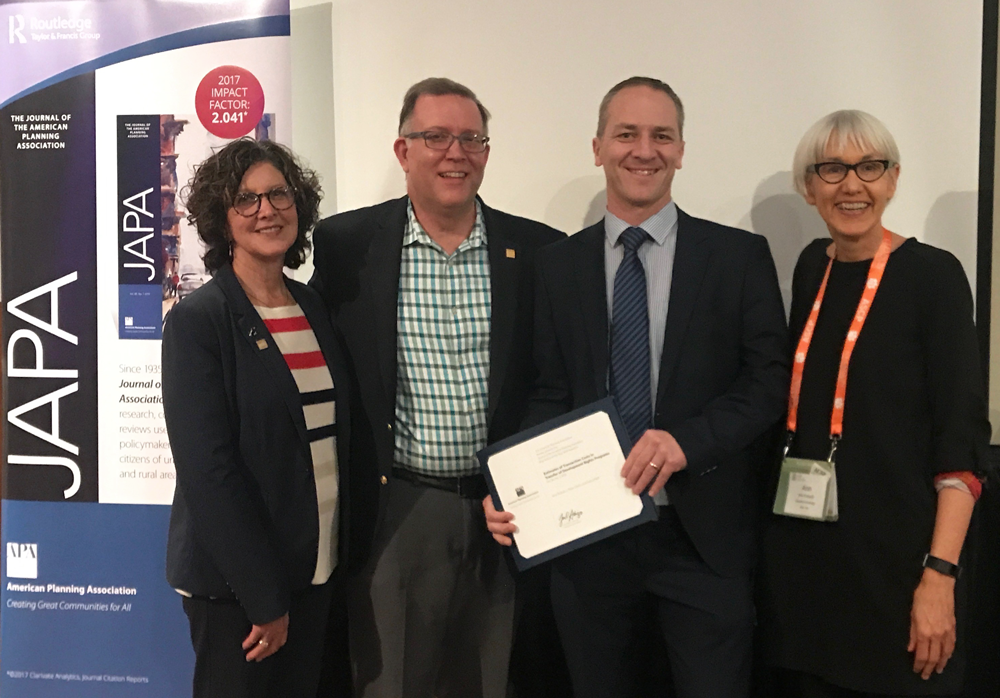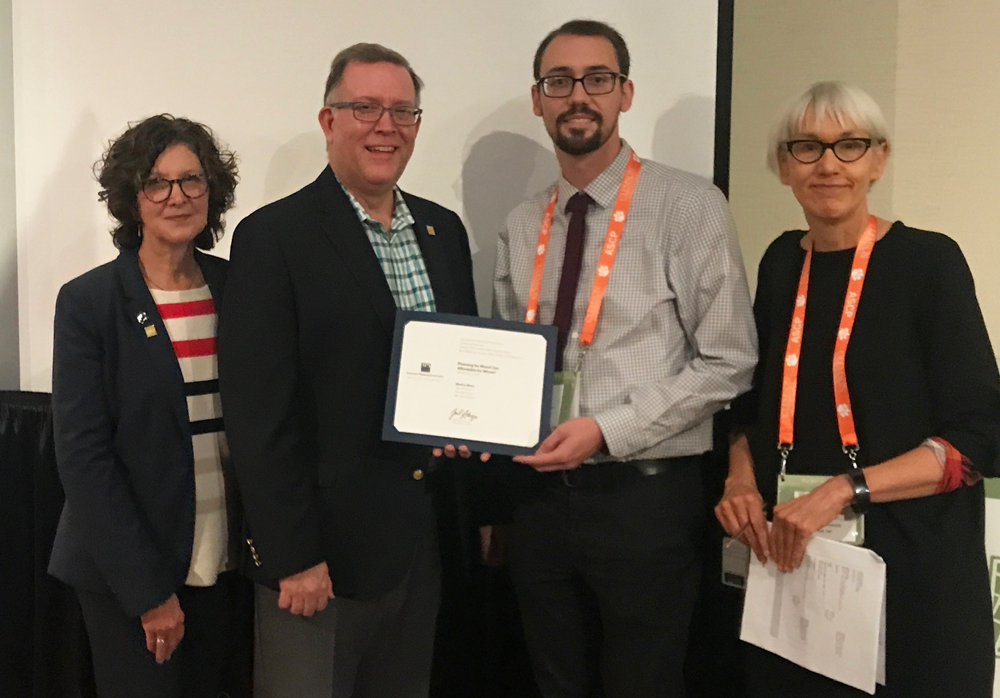JAPA Awards
Each year, APA and the Journal of the American Planning Association honor authors of excellent JAPA articles with the Best Article Awards. Members of the JAPA Editorial Advisory Board serve as judges, and selections are made based on several criteria, which include making a significant contribution to the literature of the planning profession, having the potential to change the nature of discourse on the given topic, and providing useful insights or implications for planning practice or public policy.
2022 Award Recipients
JAPA Article of the Year Award
"Jobs–Housing Balance Re-Re-Visited"
Evelyn Blumenberg, Hannah King
Best JAPA Article by an Emerging Scholar Award
"Housing Single Women"
Julia Gabriele Harten
Previous JAPA Article of the Year Award Recipients
2021
"Energy Cost Burdens for Low-Income and Minority Households"
Constantine E. Kontokosta, Vincent J. Reina, and Bartosz Bonczak
2020
"Who Cares? Arnstein's Ladder, the Emotional Paradox of Public Engagement, and (Re)imagining Planning as Caring"
Ward Lyles, AICP, and Stacey Swearingen White
2019
"Estimates of Transaction Costs in Transfer of Development Rights Programs" (Vol. 84, No. 1)
Sina Shahab, J. Peter Clinch, and Eoin O'Neill

AICP President Deborah Lawlor, FAICP; APA President Kurt Christiansen, FAICP; and Journal of the American Planning Association Editor Ann Forsyth, PhD, present the 2019 JAPA Best Article Award to one of the three authors, Associate Professor Eoin O’Neill of University College Dublin (holding certificate). The presentation was made at the 2019 ACSP conference in Greenville, South Carolina.
Transfer of development rights programs have been implemented in 36 states as a market-based approach to preserving farmlands and open space while redirecting future development to targeted areas. However, the authors point out that participating in TDR programs involves transaction costs over and above paying for TDR credits. The authors investigated such costs in four countywide TDR programs in Maryland, a TDR pioneer, by interviewing multiple program participants.
They found that, excluding the initial public-sector costs of establishing the programs, total transaction costs ranged from 13 percent to 21 percent of total TDR costs per transaction and were largely borne by the private sector.
Their conclusion: Planners can work to reduce transaction costs by better constructing TDR programs and providing greater information on TDR sale prices and potential buyers and sellers.
2018
"Measuring Informal Housing Production in California Cities" (Vol. 83, No.4)
Jake Wegmann and Sarah Mawhorter
From vol. 83, this article explores a largely ignored planning issue in the U.S. context: the growth and management of informal or unregulated housing within the boundaries of incorporated cities. Planners have long assumed that informal housing — structures built outside the formal or even legal housing sector — is only an issue in developing countries or a function of colonia development along the U.S.–Mexico border. The authors show conclusively that informal housing, which includes converted garages and unpermitted home additions and houses or apartments subdivided into several separate units, constitute a significant portion of all housing growth, particularly affordable housing growth, within the corporate limits of many California cities. It is a pattern that they are sure can be seen throughout the U.S.
The authors develop a method to calculate the number of informal units in California cities, one they believe cities across the country can use with readily available local data to understand the extent of the informal housing sector within their own boundaries. Wegmann and Mawhorter see this as the first step in dealing appropriately and humanely with a complicated issue that challenges planners, who are often caught between wanting to improve housing stock and neighborhoods by enforcing planning regulations and building codes on the one hand and, on the other, seeking to ensure housing is available for the millions of Americans too poor to secure safe and affordable homes, particularly in high-growth and expensive cities.
2017
"Do Planners Create Homogenous Neighborhoods of Rich and Poor?" (Vol. 82, No. 1)
Michael Lens and Paavo Monkkonen
Income segregation is the worst it has been in over 40 years, clustering poor people in areas with limited resources or job opportunities, and rich people in communities with drawbridge mentalities and disproportionate political power. Unlike income equality, income segregation is amenable to the skills and policies municipal city planners have at their disposal.
Lens and Monkkonen use new analytical tools to address these issues in 95 of the largest U.S. metro areas. They find that there is a complex relationship between land-use controls and income segregation; some local regulations are more linked to income segregation than others. More citizen involvement and independent reviews for project approval and zoning changes are associated with more income segregation, density restrictions are the worst culprit. State level planning mandates, in contrast, are associated with less income segregation.
The researchers also find that income segregation itself is complicated; most metropolitan areas are experiencing greater spatial concentrations of rich households than poor households. Inclusionary zoning policies, moreover, tend to reduce the concentration of the poor without addressing the spatial segregation of the rich. Lens and Monkkonen conclude that the local nature of land-use planning often exacerbates tendencies toward income segregation, while state level involvement and planning mandates relieve them.
2016
"Evaluation of Networks of Plans and Vulnerability to Hazards and Climate Change: A Resilience Scorecard" (Vol.81, No. 4)
Philip Berke, Galen Newman, Jaekyung Lee, Tabitha Combs, Carl Kolosna, and David Salvesen
To help communities integrate their local plans the authors developed a resilience scorecard that first evaluates the degree to which the network of local plans in any community targets areas most prone to hazards. The scorecard then evaluates how well local plans are coordinated to address the hazards in those areas.
The authors test the resilience scorecard in Washington, North Carolina, a community vulnerable to coastal floods and projected sea-level rise. They find that local plans are not fully consistent and do not always address the areas in a community most vulnerable to floods or sea-level risks; moreover, some plans actually increase vulnerability to hazards.
The authors suggest that planners can use the scorecard to identify when and where local plans are in conflict and whether they focus on the local areas most vulnerable to specific hazards. With the information gathered using the scorecard, planners can inform the public and decision makers about missed opportunities to improve local hazard mitigation planning. This tool adds to resources already available from the Federal Emergency Management Agency and other federal agencies in the form of widely available databases that provide local planners with crucial information needed to adequately evaluate the network of local plans.
Previous Best JAPA Article by an Early Career Scholar Award Recipients
2021
"Trade Uber for a Bus?"
Xiaoxia Dong
2020
"Redefining Car Access: Ride-Hail Travel and Use in Los Angeles"
Anne Brown
2019
"Planning for Mixed Use: Affordable for Whom?" (Vol. 84, No.1)
Markus Moos, and co-authors Tara Vinodrai, Nick Revington, and Michael Seasons

AICP President Deborah Lawlor, FAICP; APA President Kurt Christiansen, FAICP; and Journal of the American Planning Association Editor Ann Forsyth, PhD, present the 2019 JAPA Best Article by an Early Career Scholar Award to one of the article's co-authors, Nick Revington of the University of Waterloo, Canada (holding certificate), who accepted on behalf of award recipient Markus Moos. The presentation was made at the 2019 ACSP conference in Greenville, South Carolina.
The authors examined the effects of mixed use zoning on housing affordability in Toronto between 1991 and 2006 and concluded that housing in mixed use zones remained less affordable than housing in the rest of the city and in the metropolitan region.
They looked at affordability by occupational grouping and found that high-income service occupations experienced improved affordability while lower-wage service, trade, and manufacturing occupations experienced stagnant or worsening affordability.
They proposed that planners should consider a range of policy measures to offset the unintentional outcomes of mixed use developments and ensure affordability within mixed use zones, such as inclusionary zoning, density bonuses linked to affordable housing, and affordable housing trusts.
2018
"Achieving Regional Housing Planning Objectives; Directing Affordable Housing to Jobs-Rich Neighborhoods in the San Francisco Bay Area" (Vol. 83, No. 2)
Matthew Palm
The paper, coauthored by UC Davis professor Deb Niemeier, evaluated the effectiveness of the Association of Bay Area Governments, a voluntary regional planning organization in San Francisco, in directing affordable housing to jobs-rich areas to facilitate employment of lower income workers and reduce commuting costs. The authors assess what happened after ABAG changed the way it required localities in the region to allocate affordable housing under a state-mandated program; it shifted from a fair-share allocation model in which each locality planned for a specific number of affordable units to a method that distributed affordable units to areas with the most jobs. They compared the actual location of low-income housing produced after the policy change to the previous locations of comparable housing and to results in Los Angeles and San Diego, regions that had kept the fair-share allocation policy.
They also found that ABAG's policy shift was associated with a 104 percent improvement in the balance of housing and jobs at the local level; affordable housing units were more likely to locate in jobs-rich areas and more likely to do so than in San Diego and Los Angeles (where the jobs-housing balance decreased). The authors conclude that voluntary regional planning agencies can impact the production and location of affordable housing. They recommend that planners in states with affordable housing mandates or that require an affordable housing element in local comprehensive plans require localities to direct affordable housing to jobs-rich neighborhoods.


